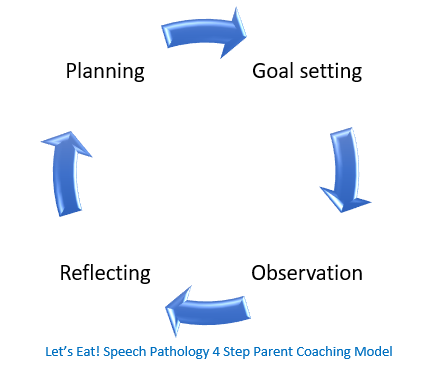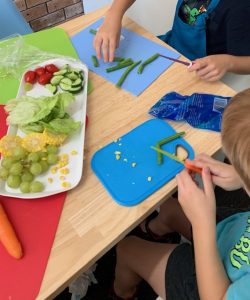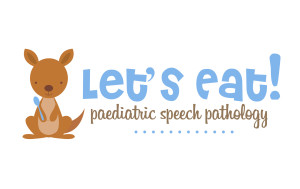
For the last 2 weeks, we have successfully helped many children with feeding difficulties. For older children, sitting at a computer is easy. But for younger children, this isn’t exactly possible. So for these children, we have been using an early intervention parent coaching method.
So what is this early intervention method and how do we use it?
We devised a 4 step parent coaching feeding model

Step 1: Goal settings
These are your goals – what is hard at home, what steps do we need to make change. Some of these challenges around food might be
- Encouraging your child to sit at the table for meals
- Expanding your child’s diet
- Helping your child progress through textures e.g. finger foods
Step 2: Observation
Before each session, you will send us videos of your child eating. We will then review these with you during your session time. If you’re not sure what to send, then don’t worry, our email s before your session guide you on what foods to video and how to video it.
Alternatively Step 2 might be more focused on talking through the foods you have in your kitchen and menu planning with you to help broaden your child’s food range. We might review chewing strategies or feeding tools with you during this stage as well
Step 3: Reflecting
We will review with you what has worked, reflect on why some strategies didn’t work and build up your problem-solving skills around feeding strategies. This step is powerful in giving you the skills to support your child. When devising new strategies, we talk about the “what if” scenarios with you so we together can pre-empt any challenges that may present at home.
Step 4: Planning
Stage 4 is writing it down and breaking it down into steps, so they are achievable. Then we’ve come full circle and are back to the joint planning phase for next time.
Here is an example from my own caseload and a family I’ve been doing coaching with for their 2 ½ year old. We had our second meeting last week.
Step 1: Goal setting
We began by discussing successes (child sitting with mum and dad for two meals!) and challenges (weaning the formula bottle before bed). We bottle weaning as our priority goal.
Step 2: Observation
Mum talked me though the current routine, showed me her bottle diary, and told me about some of the previous attempts to drop bottles. We talked about some strategies to wean the formula amount
Step 3: Reflecting
We individualised strategies around weaning so that it worked for this family’s busy life
Step 4: Planning
We wrote down the plan and made a time to meet up in 2 weeks.
Another case (for a preschool fussy eater) I supported this week went along these lines
Step 1: Goal setting
After the initial assessment, I caught up with the mum via Telehealth (Zoom) and she was keen to support her child to more fruit. I knew from the assessment that her daughter’s chewing skills were within normal range but that there was some general fear issues of fruit and vegetables at home for this little pre-schooler.
Step 2: Observation
During our initial assessment, we talked about cooking together so mum sent a video of her daughter cooking with her at home. We reviewed the video during the session and talked about the finer body language cues that told us whether her daughter was struggling or succeeding with different cooking tasks.
Step 3: Reflecting
We reflected together from a food sensory perspective, why some of these food tasks were hard and why some were easier. We set up specific recipe ideas around specific fruits to trial
Step 4: Planning
I emailed her a few food games activities with individualised suggestions for her daughter. The steps were small enough so that they were achievable (in a household of 3 children) but also food sourcing wise easy in our crazy COVID-19 climate. I look forward to hearing how her little fussy eater did in our next parent coaching session.

So feeding therapy can be done in the baby and preschool world of feeding difficulties. Our goal is to empower you to make changes in your home. And what better place to do it by in your child’s natural routine where they have their familiar cups, bowls and spoons.
At Let’s Eat Speech! we love the collaboration that parent coaching brings for our little ones. You are the expert on your child, and we provide the skills and expertise in feeding techniques that come together to create change and help you achieve your goals. It’s a team effort!
I look forward to achieving those goals with you,
Until next time
Ashleigh
Paediatric Feeding Speech Pathologist @ Let’s Eat! Paediatric Speech Pathology
This website and information on this blog post is provided for educational purposes. It is not meant or intended to replace Speech Pathology assessment and management nor medical or nutritional care for a child. It is recommended that you discuss any concerns or questions you might have with your Speech Pathologist and managing Doctor and develop an individualised team plan specifically for your child.

About this Author
Ashleigh O’Loughlin is a Speech Pathologist with 6 years’ experience; she has specific experience in feeding difficulties and children with Autism Spectrum Disorders and Special needs. She has worked all around Australia including remote Northern Territory and Perth (Western Australia). She joined the Let’s Eat Speech Team in 2020 and works with Valerie Gent in their clinic in Wallsend (and now in Telehealth). You can email Ashleigh now on ashleigh@letseatspeech.com.au or head to the website www.letseatspeech.com.au


